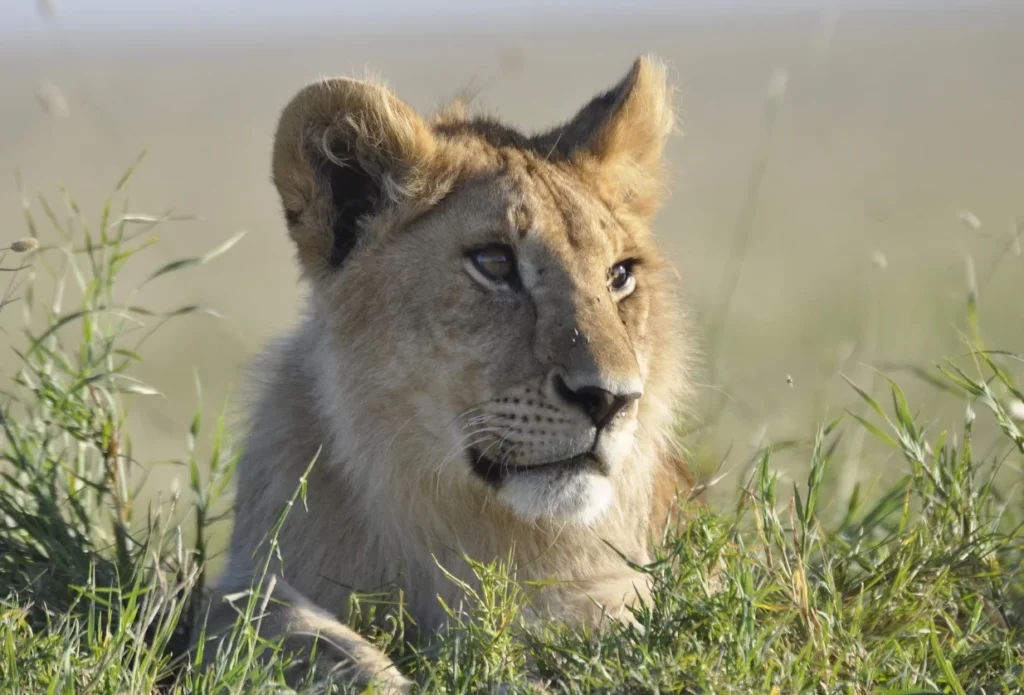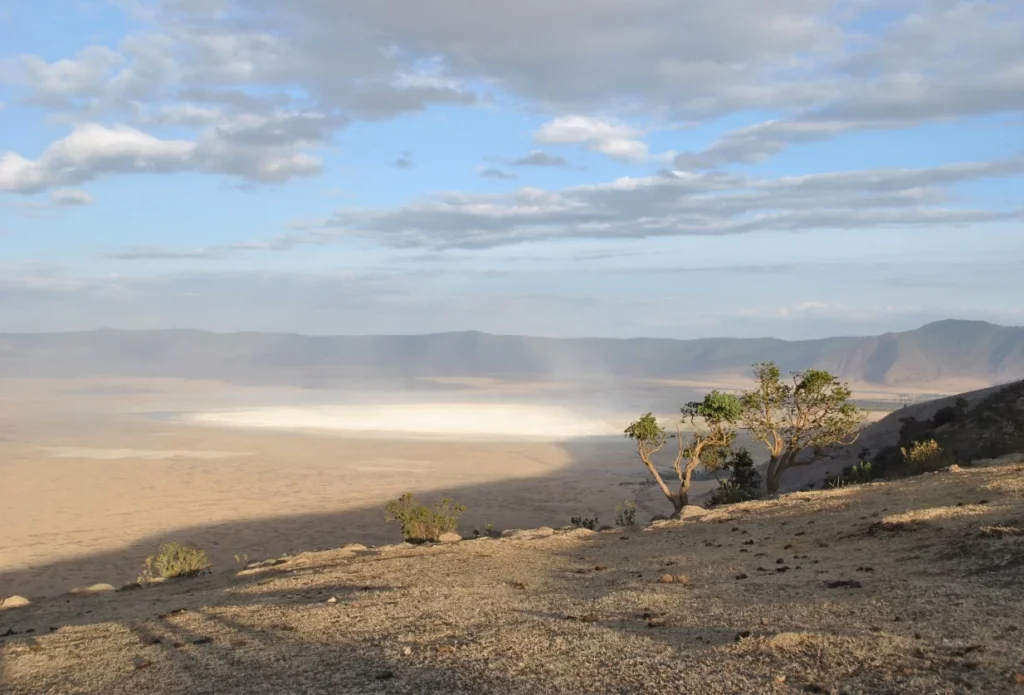TARANGIRE NATIONAL PARK
HIGHLIGHTS

Sixth largest National park in Tanzania

A haven for avian species enthusiasts

One of the best places to spot elephants and baobab trees
BEST TIME TO GO
The weather during these months is dry and the park experiences minimal to no rainfall. Dry weather conditions make animals move out of the park and gather around water sources, making wildlife viewing easier for tourists.
BEST WEATHER
The ideal weather to visit Tarangire National Park Tanzania for safari is dry and sunny when the winds are clear and gentle. You will only find this weather from June start to October end when the bush thins out and animals migrate to the Tarangire River to drink water.
WORST WEATHER
Usually, the rainy season that runs from March to April experiences constant short rains with thunderstorms. This type of weather makes enjoying a good time outside impossible. That is why the weather is not well-suited for safari and other outdoor activities. However, the wet season is the best time to witness lovely green vegetation and migratory birds.
BEST TIME
July to November is the best time for wildlife sightings during game drives in Tarangire Park. That is because plenty of wildlife roam the park and the park’s less dense vegetation improves visibility. It adds to the tourists’ overall safari experience.
HIGH SEASON
Since most tourists seek iconic wildlife encounters or beautiful landscapes, they mostly visit the park during the dry season, which is undoubtedly the ideal environment for a memorable tarangire national park safari experience. That means Tarangire’s high season coincides with the dry season and the park will have many tourists during this period.
LOW SEASON
Due to the high risk of malaria and fewer chances of spotting animals, the wet season is considered a low season in Tarangire National Park. However, this time is best for people seeking a less crowded Tanzania safari experience.
ABOUT TARANGIRE
Tarangire National Park’s diverse landscapes (composed of granitic ridges, river valleys and swamps) and large populations of elephants and other wildlife species make it a popular destination for wildlife lovers visiting Tanzania. Located on the Northern side of Tanzania, the park is named after the Tarangire River- the main source of freshwater for animals that crosses the park and attracts large herds of wildebeest, elephants, lions, leopards, zebras and many more.
Spread over approximately 2,600 sq km, Tarangire is the perfect place to spot wildlife roaming freely in their natural habitat. Besides elephants and big cats, you will also find over 500 bird species, including Ostrich, in the park.
The park’s landscape provides everything tourists need to enjoy scenic and diverse surroundings, from grasslands and swamps to acacia woodlands and baobab trees. Many tourists also prefer to visit Tarangire National Park because the park is a popular spot for wildebeest migration.
TARANGIRE TRIPS
If you are interested in exploring a fantastic birding destination that is home to vast herds of elephants and stunning landscapes, why wait? Check out some of the best Tarangire safari tours by Reality Tours & Safaris, and do not miss any chance to visit this hugely underrated Tanzania safari highlight- Tarangire National Park.

6 Days / 5 Nights Lake Manyara / Serengeti / Ngorongoro / Tarangire
- Lake Manyara National Park
- Serengeti National Park
- Ngorongoro Crater
- Tarangire National Park

3 Days / 2 Nights Tarangire / Lake Manyara / Ngorongoro Crater
- Tarangire National Park
- Lake Manyara National Park
- Ngorongoro Crater
Contact Us

Noemi Casado, Spain
Suzanne Richard, England
Nathan Burke, USA
Jennifer Riley, USA
John Mathew, USA
FAQ's
Tarangire National Park is located in the northern circuit of Tanzania, East Africa. The park’s name is derived from the Tarangire River, providing an essential water source for the wildlife that inhabits the area. As it is situated in the southwest of Arusha, the park is easily accessible by road. It borders the south and the Serengeti National Park to the northwest, making it a significant part of Tanzania’s exclusive conservation network. With all the magnificent landscapes and unique wildlife experiences, Tarangire National Park is a must-visit place for nature admirers.
Tarangire National Park spreads across the landscape of approximately 2850 sq km (1,100sq miles). This makes the park the sixth-largest national park in Tanzania, extending a wide area of varied landscapes and ecosystems. This largest park preserves a wide variety of habitats from grasslands to woodlands and seasonal marshlands. Regardless of itsize, Tarangire is just one part of Tanzania’s widest conservation network.
Tarangire National Park provides a wide variety of activities that satisfy both adventurous travellers and those who want to experience safaris. The main activities which are available in Tarangire are:
●Game Drives: Guided game drives are the classic safari experience in Tarangire. It allows you to discover the park’s varied abundant wildlife and varied landscapes.
●Walking Safaris: They provide a closer connection to nature and observe miniature wildlife.
●Birdwatching: It gives a chance to spot a diverse collection of avian species, raptors, and rare migratory birds.
●Cultural Visits: You can learn Maasai customs and traditions and experience traditional dances.
●Photography Safaris: With amazing landscapes, and wildlife behaviour they offer specialized photography directed by experienced guides.
Yes, it is safe to visit Tarangire National Park. The park is smoothly handled and certain priorities are taken for visitors safety by the park authorities. During safaris, you are advised to follow the guidelines which are informed by the experienced safari guides. You have to maintain a minimal safe distance from wildlife and stick to park regulations at all times. Even on safaris, large mammals like lions, elephants, and buffalos are there and they won’t harm you.
In general, they are habituated to safari vehicles and will not become a threat to visitors when proper guidelines are followed. With all the safety measures, you can enjoy a safe and amazing experience in Tarangire National Park.
Yes, there you can accommodate inside the park. Tarangire offers visitors to engage them in the wilderness and enjoy seamless wildlife experiences. They provide unique facilities ranging from luxury lodges to tented camps and experience the park’s amusing landscapes. Staying inside the park permits visitors to completely involve themselves in the beauty of nature, with the further convenience of being close to the wilderness and experiencing the sounds and sights throughout their stay. Book your accommodations in advance to ensure your preferred lodging inside the park.
It is not compulsory to have a guide to explore Tarangire National Park. Guides hold valuable insights into the park’s biodiversity, conservation efforts, and wildlife behaviour. To enhance a great safari experience and ensure safety during safaris, it is advised to have a knowledgeable and experienced guide. They can also provide fascinating information and show mesmerizing sceneries of the park’s flora and its unique plant species.
Furthermore, guides give more priority to the visitor’s safety and make sure that they follow all park regulations and take specified precautions to minimize the risks related to wildlife encounters.
The entry cost to Tarangire National Park generally varies based on several factors, like nationality, age, and vehicle type. The entry fees for people from other countries to the park are higher as compared to Tanzanian citizens and African residents. For Tanzania citizens and Africans, entry fees range from $10 to $20 per person per day with additional discounts for children. For non-residents, it costs from $25 to $60 per person per day. Anyhow children below 5 yrs can opt for free entry inside the park.
Additional charges will cost for the vehicle entry fees based on the type of vehicle like safari vehicle, bus, or motorcycle. These entry fees might be subject to change, so you should enquire about current rates before planning your visit
Tarangire National Park shines apart among Tanzania’s well-known parks due to its unique combination of varied ecosystems, abundant wildlife, and amusing landscapes, making it an exclusive destination for safari enthusiasts. One of the special features of Tarangire is its classic baobab trees, which mark the landscape and create a fantastic scenery for viewing the wildlife. Moreover, Tarangire features as one of the beauty for wildlife during the dry season, with large herds of elephants, zebras and other species. Birdwatchers can view over 550 bird species recorded within the parks including migratory birds. Overall, Tarangire Park is blended with scenic beauty and generous wildlife.
Yes, camping facilities are available in Tarangire National Park. The park allows visitors to involve themselves in the wildlife and enjoy more scenic nature by providing designated camps furnished with basic facilities. These camps facilitate picnic areas and allow visitors to cook food and enjoy outdoor dining. Camping in the Tarangire makes you completely connect with nature, with the sounds of wilderness throughout the night. It is necessary to note that camping in Tarangire needs pre-booking and cooperation with park regulations and guidelines.
Tarangire National Park is an incredible place to visit distinct bird species. The unique species that can be viewed in the park include the African Fish Eagle, Yellow-collared lovebird, Lilac-breasted Roller, Secretary Birds, Kori Bustard, Yellow-billed hornbill, Superb Starling, and many more.
To experience a safe and mesmerizing adventure for both visitors and wildlife, you have to follow park rules and regulations. Some of the essential rules you have to be aware of are:
●Entry Fees: To enter the Tarangire National Park, you have to pay entry fees based on park rules.
●Speed Limits: The speed should be limited, and prohibited especially on park roads and near animals.
●No Feeding Wildlife: Feeding wildlife is strictly prohibited in Tarangire National Park.
●No Littering: To keep the park clean and tidy, you are required to dispose of your litter properly.
●Follow Guide Instructions: Respect wildlife, do not approach animals too closely, and follow campfire regulations. You must follow the instructions of guides all the time for your safety.

